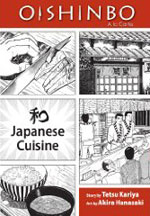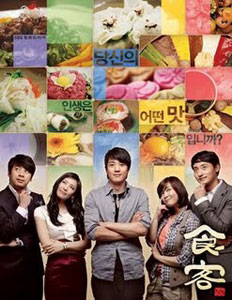 The other night I finally got a chance to read the first volume of the much-talked about Japanese food manga, Oishinbo, by Tetsu Kariya and Akira Hanasaki. This is the story of a cynical journalist, Yamaoka Shirō, who has been assigned the task of creating the “ultimate menu” of Japanese cuisine by the newspaper that employs him. But a rival newspaper is chasing the same goal, and their efforts are being led by the famous gourmet, Kaibara Yūzan, who just happens to be Yamaoka’s estranged father. So as Yamaoko researches the best traditions of Japanese food, he continually comes into conflict with his father and his father’s strong opinions.
The other night I finally got a chance to read the first volume of the much-talked about Japanese food manga, Oishinbo, by Tetsu Kariya and Akira Hanasaki. This is the story of a cynical journalist, Yamaoka Shirō, who has been assigned the task of creating the “ultimate menu” of Japanese cuisine by the newspaper that employs him. But a rival newspaper is chasing the same goal, and their efforts are being led by the famous gourmet, Kaibara Yūzan, who just happens to be Yamaoka’s estranged father. So as Yamaoko researches the best traditions of Japanese food, he continually comes into conflict with his father and his father’s strong opinions.
Over 100 volumes of this series have been published in Japan, and the “A la Carte” editions licensed by Viz collect highlights from this long run into convenient volume-length chunks. The abridged nature of this version is pretty noticeable when you read; there are obvious references to missing events, and the first chapter begins very much in medias res. (Reading the flaps and opening summary helps a lot; I don’t recommend skipping the preliminaries.) But overall the greatest hits nature of this volume is less problematic for readers than I expected. After all, there might be a nominal plot driving the episodes (the challenge of the “ultimate menu” and Yamaoko’s rivalry with his father), but who are we kidding? This story is all about the food.
I happen to have a great fondness for stories about food, so I enjoyed reading Oishinbo. The exhaustive detail would be overkill in another story, but here it is a huge part of the manga’s charm. My main issue with the story was actually a very personal one. As I read, I kept thinking, “This is all well and good, but what I would really love to read, being Korean-American, is a comic about Korean food!”
This is not just wishful thinking on my part. There is a well-known manhwa that does for Korean food what Oishinbo does for Japanese food. Shikgaek is a 20-volume series by Heo Yeong-man about a talented young chef, his family, and the traditions of Korean cuisine. I suspect its chances of being licensed are pretty much nonexistent, given the limited market for manhwa in the states, but I will tell you about it anyway–or at least what I know of it secondhand via the live-action tv drama based upon it.
 The protagonist of Shikgaek, Seong Chan, is a talented but inexperienced junior chef working in a famous Korean restaurant. Chef Oh, the owner, claims descent from the last royal chef of the Joseon dynasty and was a friend of Seong Chan’s father; he took Seong Chan in after he was orphaned. Seong Chan thinks of Chef Oh like a father, and of Chef Oh’s son, Bong Ju, like a brother. But Chef Oh puts a huge strain on his sons’ relationship when he announces that he is holding a cooking competition to determine who will be his successor: up till then, everyone, including Bong Ju and Seong Chan, has simply assumed that Bong Ju will inherit, being the eldest son. The brothers become rivals. And no one can predict who will win the competition or what will be left of Chef Oh’s family when it is over.
The protagonist of Shikgaek, Seong Chan, is a talented but inexperienced junior chef working in a famous Korean restaurant. Chef Oh, the owner, claims descent from the last royal chef of the Joseon dynasty and was a friend of Seong Chan’s father; he took Seong Chan in after he was orphaned. Seong Chan thinks of Chef Oh like a father, and of Chef Oh’s son, Bong Ju, like a brother. But Chef Oh puts a huge strain on his sons’ relationship when he announces that he is holding a cooking competition to determine who will be his successor: up till then, everyone, including Bong Ju and Seong Chan, has simply assumed that Bong Ju will inherit, being the eldest son. The brothers become rivals. And no one can predict who will win the competition or what will be left of Chef Oh’s family when it is over.
This isn’t a particularly subtle piece of storytelling, but it is still a good one. Seong Chan’s pursuit of the best ingredients and recipes takes him all over Korea; the cooking challenges that make up the competition are contrived but still entertaining. I will not attempt to describe the many subplots, but I will note that the supporting cast includes a perky food reporter, a beautiful administrator, a cryptic fortune-teller, and a tragic cow. And the individual episodes that make up the narrative do a nice job of capturing the way that food ties people to their identities, families, and heritage.
It may be that the tv drama is actually an improvement upon the source manhwa. I really can’t say whether that is or is not the case, and I haven’t been able to find much information on the web that sheds light on the matter. I do hope, however, that a licensed version of this manhwa will one day give me a chance to find out! In the meantime, if you’ve been intrigued by my description of the tv show, you may be in luck. English-subtitled versions are available in the US and Canada.
Oishinbo is published in the US by Viz; new volumes are being released every other month. Residents of the US and Canada can watch English-subtitled versions of Shikgaek online (legally) at DramaFever under the title Gourmet; subtitled dvds are also available from Netflix1 under the title The Grand Chef.
1 Note that the movie adaptation of the manhwa is also available at Netflix under the title The Grand Chef. While I recommend the tv drama, I don’t recommend the film, which reduces too many of the characters to caricatures. So be careful to add the right dvd to your queue, unless you’re in search of something unintentionally hilarious!
Pingback: Monday updates « MangaBlog
September 21, 2009 at 6:32 am
Wow, Shikgaek sounds fabulous. I do hope the manhwa gets licensed eventually!
September 21, 2009 at 3:27 pm
I suspect the odds of licensing are so low that I should just accept that I will just have to learn Korean to read it! But you never know–publishers have surprised me before.
September 21, 2009 at 3:40 pm
Joy! I have been wondering if you have been reading this series (Oishinbo that is) – I have been reading them and loving them! The exhaustive detail is awesome :) I get very tired of the father/son drama though. Shikgaek sounds great too! Speaking of manhwa I have also been enjoying the “Color” trilogy by Kim Dong Hwa – got my hands on Color of Heaven today. First Second did a really great job on those books – they’re gorgeous.
September 21, 2009 at 4:08 pm
@Erin – I’m especially looking forward to the one about izakaya, since I love going to them so much. If you’re ever in the area, I will take you to one!
I’ve been looking at purchasing the “Color” trilogy for SJPL but haven’t read it yet. I’d like to do both, but I’m still figuring out how far my budget will stretch. (I blanch every time I contemplate buying 30 volumes in One Piece in the first half of 2010 for 18 (soon to be 19) locations.)
Pingback: Kdramas for beginners, part 2 :: Joy Kim